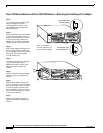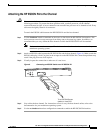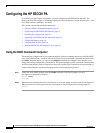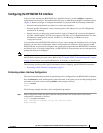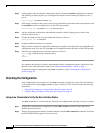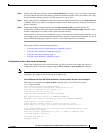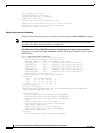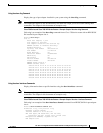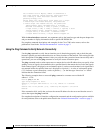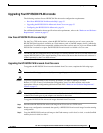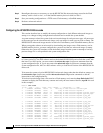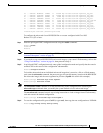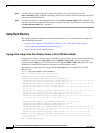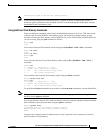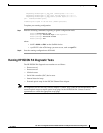
32
PA-4C-E 1-Port High-Performance ESCON Channel Port Adapter Installation and Configuration
OL-3743-02
Configuring the HP ESCON PA
Data transfer rate 12 Mbytes, number of subchannels 0
Last input 00:14:09, output 00:00:58, output hang never
Last clearing of "show interface" counters never
Queueing strategy: fifo
Output queue 0/40, 69129 drops; input queue 0/75, 0 drops
5 minute input rate 220000 bits/sec, 239 packets/sec
5 minute output rate 289000 bits/sec, 252 packets/sec
788256 packets input, 84718668 bytes, 0 no buffer
Received 0 broadcasts, 0 runts, 0 giants, 0 throttles
0 input errors, 0 CRC, 0 frame, 0 overrun, 0 ignored, 0 abort
1378169 packets output, 680323725 bytes, 0 underruns
0 output errors, 0 collisions, 7 interface resets
0 output buffer failures, 0 output buffers swapped out
With the show interfaces command, use arguments such as the interface type and the port adapter slot
and port number to display information about a specific HP ESCON PA.
For complete command descriptions and examples for the Cisco 7200 series routers, refer to the
publications listed in the “Related Documentation” section on page 3.
Using the Ping Command to Verify Network Connectivity
Use the ping command to verify that an interface port is functioning properly and to check the path
between a specific port and connected devices at various locations on the network. This section provides
brief descriptions of the ping command. After you verify that the system has booted successfully and is
operational, you can use the ping command to verify the status of interface ports.
The ping command sends an echo request out to a remote device at the IP address that you specify. After
sending a series of signals, the command waits a specified time for the remote device to echo the signals.
Each returned signal is displayed as an exclamation point (!) on the console terminal; each signal that is
not returned before the specified time-out is displayed as a period (.). A series of exclamation points
(!!!!!) indicates a good connection; a series of periods (.....) or the messages “timed out” or “failed”
indicate that the connection failed.
The following example shows a successful ping command to a remote server with the IP
address 1.1.1.10:
Router# ping 1.1.1.10
Type escape sequence to abort.
Sending 5, 100-byte ICMP Echoes to 1.1.1.10, timeout is 2 seconds:
!!!!!
Success rate is 100 percent (5/5), round-trip min/avg/max = 1/15/64 ms
Router#
If the connection fails, verify that you have the correct IP address for the server and that the server is
active, then repeat the ping command.
For complete descriptions of interface configuration commands and the configuration options available
for each platform, refer to the publications listed in the “Related Documentation” section on page 3.



